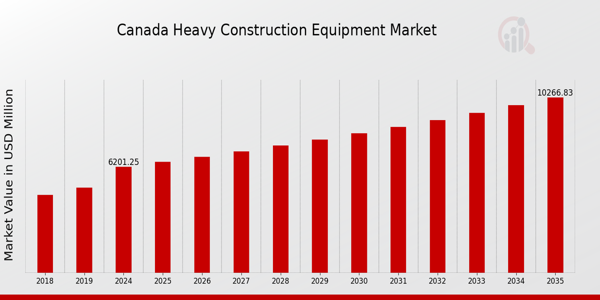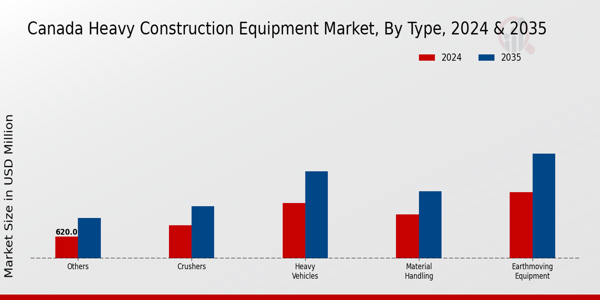Canada Heavy Construction Equipment Market Overview
As per MRFR analysis, the Canada Heavy Construction Equipment Market Size was estimated at 5,928.57 (USD Million) in 2023. The Canada Heavy Construction Equipment Industry is expected to grow from 6,201.25(USD Million) in 2024 to 10,267.64 (USD Million) by 2035. The Canada Heavy Construction Equipment Market CAGR (growth rate) is expected to be around 4.69% during the forecast period (2025 - 2035)
Key Canada Heavy Construction Equipment Market Trends Highlighted
The Canada Heavy Construction Equipment Market is growing due to increased activity in infrastructure development, reason for the growth includes private investments. The Canadian government has placed extra attention on developing the transportation system, this includes the construction of new roads, bridges, and railroads. The development in infrastructure is aimed at increasing mobility and further contributing towards economic activities. In addition, there is a growing need towards the construction of new renewable energy projects which is resulting in the demand for construction equipment. As Canada moves towards sustainable solutions, there is an increasing demand for equipment that facilitate green construction practices. These markets in Canada are driven and funded by new technologies like automation and telematics.
Canadian firms are starting to use new technologies that enable better use of the equipment and lower operation costs. This trend is becoming pronounced in the busy cities where firms want to boost productivity because wage rates are increasing. In addition, the focus on urban renewal and smart cities creates an opportunity for the heavy construction equipment market. Recently, there has been an increasing demand for machines that are eco-friendly and comply with strict green policies. The Canadian government also has set rules for reducing emissions, which is causing manufacturers and operators to spend money on purchasing newer and more efficient machines to use.
This goes hand in hand with the social expectation regarding businesses integrating sustainable practices against societal norms. Furthermore, local production and sourcing is becoming more popular because it promotes employment opportunities and strengthens economic stability. In a nutshell, the Canada Heavy Construction Equipment Market is moving towards a more innovative, sustainable, and infrastructure integrated economy, which indicates that there is a shift in the industry.

Canada Heavy Construction Equipment Market Drivers
Infrastructure Development Investments
Canada's heavy construction equipment market is significantly driven by ongoing investments in infrastructure development across the country. The Government of Canada has committed substantial funding towards projects aimed at upgrading transportation networks, public transit systems, and water management facilities. For instance, recent reports from the federal government have highlighted a commitment of over CAD 180 billion towards infrastructure over the next 12 years.This commitment ensures that the demand for heavy construction equipment remains high as more contractors undertake projects to meet these development goals. Industry associations, such as the Canadian Construction Association, emphasize that these investments will not only enhance regional connectivity but also create numerous jobs, thus stimulating further demand for heavy construction equipment across Canada. With projects in highly populated areas like Toronto, Vancouver, and Montreal, the growth potential for the Canada Heavy Construction Equipment Market Industry remains robust well into the next decade.
Urbanization and Population Growth
The rapid urbanization and population growth in Canada is a crucial driver of the heavy construction equipment market. As cities expand, the demand for residential, commercial, and industrial construction rises significantly. Statistics Canada projects a population increase of approximately 8 million people by 2041, with a majority relocating to urban centers. This escalation necessitates new construction projects to accommodate the growing populace, subsequently increasing the demand for heavy construction equipment.Furthermore, the Canadian Home Builders' Association reports that housing starts have reached over 200,000 annually in recent years, indicating a strong market for construction activity, thereby positively influencing the Canada Heavy Construction Equipment Market Industry.
Technological Advancements in Equipment
Technological advancements in heavy construction equipment are enhancing efficiency, safety, and productivity, propelling market growth in Canada. Manufacturers are increasingly focusing on integrating smart technologies like IoT, telematics, and automation into their equipment offerings. For example, the introduction of telematics has enabled better fleet management, leading to reduced downtime and improved operational efficiency. Industry reports suggest that Canadian construction companies that have adopted these technologies have experienced productivity improvements of up to 30%.Organizations like the Association of Equipment Manufacturers highlight that ongoing innovation will continue to attract investments in modern, tech-enabled machines in the Canada Heavy Construction Equipment Market Industry, resulting in sustained growth.
Canada Heavy Construction Equipment Market Segment Insights
Heavy Construction Equipment Market Type Insights
The Canada Heavy Construction Equipment Market, categorized by Type, exhibits a diverse and multifaceted landscape that reflects the needs of various sectors including construction, mining, and infrastructure development. The Earthmoving Equipment segment is particularly crucial, as it encompasses essential machinery such as excavators and bulldozers, which play a pivotal role in excavation and material movement. The Material Handling segment focuses on the transportation and storage of materials, highlighting the importance of equipment like forklifts and conveyors that facilitate the efficient flow of construction processes.
Heavy Vehicles represent another vital component of the market, with trucks and trailers being indispensable for transporting heavy machinery and materials to construction sites across Canada’s vast geography. Additionally, the Crushers segment stands out for its significance in processing and recycling materials, thus supporting sustainability in construction initiatives. There are also other types of equipment contributing to the diversification of services within the market, showing adaptability to various project demands.
The interplay between these segments indicates a strong foundation for the Canada Heavy Construction Equipment Market, which is influenced by ongoing infrastructure projects and urban development initiatives across the country.Furthermore, advancements in technology, such as the incorporation of automation and telematics, are reshaping operational efficiencies and driving growth, providing opportunities for innovation and investment within the market. As Canada continues to focus on enhancing its infrastructure and addressing environmental concerns, the Heavy Construction Equipment Market is positioned to thrive while responding to emerging market trends and challenges.

Heavy Construction Equipment Market Application Insights
The Canada Heavy Construction Equipment Market, particularly within the Application segment, showcases a diverse range of areas critical to the construction landscape. Excavation Demolition equipment plays a vital role, facilitating site preparation and the safe elimination of structures, which is essential for new constructions. In contrast, Material Handling focuses on the efficient management of materials on job sites, pivotal in enhancing productivity and ensuring safety during operations. Heavy Lifting equipment is increasingly significant due to the rising complexity of projects, requiring advanced technology to handle large loads safely.
Additionally, Recycling Waste Management is gaining traction amid Canada's growing focus on sustainable construction practices, as these operations significantly reduce environmental impact.Tunneling also holds substantial importance, driven by infrastructure developments and urbanization, addressing transportation needs through effective underground solutions. Overall, these sub-divisions within the Canada Heavy Construction Equipment Market segmentation reflect the industry's adaptation to growing demands and evolving challenges while contributing to market growth.
Heavy Construction Equipment Market End Use Industry Insights
The Canada Heavy Construction Equipment Market, significantly influenced by various end-use industries, has displayed robust growth patterns. The versatility of heavy construction equipment is apparent across sectors such as Infrastructure and Real Estate, which play a crucial role due to Canada's ongoing urbanization and investment in public projects. In particular, the demand from the Oil Gas sector remains significant, driven by the country's vast natural resources and energy initiatives aimed at reducing carbon footprint.The Mining industry stands out as well, given Canada's rich mineral deposits, making it a vital area for heavy equipment use.Aggregates are essential for construction projects,
contributing prominently to the overall market as they support infrastructure development. Additionally, sectors like Forestry Agriculture highlight the importance of heavy machinery in managing Canada’s vast natural landscapes while meeting the challenges posed by climate change. The integration of advanced technologies also enhances operational efficiency, providing opportunities for growth and innovation within the Canada Heavy Construction Equipment Market, further solidifying its contribution to the country's economy and landscape.As industries adapt and evolve, the segmentation reflects not only the current market needs but also the adaptation to future demands and challenges.
Canada Heavy Construction Equipment Market Key Players and Competitive Insights:
The Canada Heavy Construction Equipment Market is characterized by a dynamic competitive landscape that reflects the diverse needs and requirements of various construction projects across the nation. With a robust demand fueled by ongoing infrastructure developments, urbanization, and a growing emphasis on sustainable construction practices, the market has attracted a blend of established manufacturers and emerging players. Competition in this sector is driven by innovation, technological advancements, and a focus on providing efficient, durable, and cost-effective machinery. Companies are continuously adapting to market trends and customer preferences while investing in research and development to enhance their product offerings.This competitive environment not only influences pricing strategies but also dictates service excellence and supply chain efficiencies, as firms endeavor to capture a larger market share in a landscape marked by both challenges and opportunities.Manitou has established a strong foothold in the Canada Heavy Construction Equipment Market, driven by its specialized range of telehandlers, forklifts, and aerial work platforms.
The company's focus on innovation and technology has allowed it to offer equipment tailored to the specific demands of Canadian construction sites, which often require versatile and efficient machinery to navigate challenging terrains and harsh weather conditions. Manitou's reputation for quality and reliability has contributed to its strong brand loyalty among customers, enabling it to maintain a competitive edge. Additionally, the company’s emphasis on after-sales support and customer service reinforces its presence, as clients value timely maintenance and service solutions. Through strategic partnerships and collaborations, Manitou has further solidified its position in Canada, aiding in the effective distribution of its products and services, which further enhances its reach in the region. SANY is another significant player in the Canada Heavy Construction Equipment Market, known for its diverse range of products that includes excavators, concrete machinery, and road construction equipment.
The company has rapidly expanded its market presence in Canada by offering high-quality, performance-driven equipment that meets international safety and environmental standards. SANY's strengths lie in its competitive pricing and the incorporation of advanced technology in its machinery, which enhances operational efficiency and productivity for construction companies. The company has also strategically engaged in various mergers and acquisitions, thereby increasing its capability and resources in the Canadian market, allowing it to serve clients effectively. Moreover, SANY places strong emphasis on local partnerships and collaborations, which aids in better understanding regional customer requirements and improving service delivery. This strong commitment to customer satisfaction and continuous innovation has allowed SANY to emerge as a key competitor in the Canadian heavy construction equipment landscape, positioning itself favorably for future growth.
Key Companies in the Canada Heavy Construction Equipment Market Include:
- Manitou
- SANY
- Terex
- Volvo
- Case Construction Equipment
- Liebherr
- Doosan Infracore
- Bobcat Company
- Hitachi Construction Machinery
- Komatsu
- Wacker Neuson
- Skyjack
- CNH Industrial
- Caterpillar
- JCB
Canada Heavy Construction Equipment Market Industry Developments
The Canada Heavy Construction Equipment Market has seen notable recent developments, particularly with respect to major players like Caterpillar, Volvo, and Doosan Infracore. In August 2023, Volvo announced a strategic partnership aimed at enhancing the automation and productivity of construction machinery, which plays a critical role in infrastructure projects across Canada. Furthermore, equipment values have been on the rise, driven by increased investments in public infrastructure, leading to a significant growth in market valuation.
In September 2022, SANY made strides in expanding its Canadian operations, launching a new distribution center in Ontario to streamline logistics and enhance services. On the merger and acquisition front, in mid-2023, JCB finalized its acquisition of a small Canadian manufacturing firm to boost its presence in the North American market. The increasing demand for renewable energy projects has also positively impacted companies like Liebherr and Komatsu, with their eco-friendly models gaining traction. Additionally, a report from the Canadian Construction Association noted that construction spending increased by 8.5% year over year in 2023, driven by continued investments in residential and commercial construction, with heavy equipment at the forefront of these developments.
Heavy Construction Equipment Market Segmentation Insights
Heavy Construction Equipment Market Type Outlook
- Earthmoving Equipment
- Material Handling
- Heavy Vehicles
- Crushers
- Others
Heavy Construction Equipment Market Application Outlook
- Excavation Demolition
- Material Handling
- Heavy Lifting
- Recycling Waste Management
- Tunneling
Heavy Construction Equipment Market End Use Industry Outlook
-
Metals
-
Minerals
-
Coal
-
Aggregates
-
Infrastructure
-
Real Estate
-
Oil Gas
-
Mining
-
Forestry Agriculture
-
Others
| Report Attribute/Metric Source: |
Details |
| MARKET SIZE 2023 |
5928.57(USD Million) |
| MARKET SIZE 2024 |
6201.25(USD Million) |
| MARKET SIZE 2035 |
10267.64(USD Million) |
| COMPOUND ANNUAL GROWTH RATE (CAGR) |
4.69% (2025 - 2035) |
| REPORT COVERAGE |
Revenue Forecast, Competitive Landscape, Growth Factors, and Trends |
| BASE YEAR |
2024 |
| MARKET FORECAST PERIOD |
2025 - 2035 |
| HISTORICAL DATA |
2019 - 2024 |
| MARKET FORECAST UNITS |
USD Million |
| KEY COMPANIES PROFILED |
Manitou, SANY, Terex, Volvo, Case Construction Equipment, Liebherr, Doosan Infracore, Bobcat Company, Hitachi Construction Machinery, Komatsu, Wacker Neuson, Skyjack, CNH Industrial, Caterpillar, JCB |
| SEGMENTS COVERED |
Type, Application, End Use Industry |
| KEY MARKET OPPORTUNITIES |
Infrastructure investment surge, Green technology adoption, Rental market expansion, Automation and robotics integration, Urbanization driving demand |
| KEY MARKET DYNAMICS |
Infrastructure investment growth, Technological advancements, Regulatory environment changes, Increased rental market participation, Skilled labor shortages |
| COUNTRIES COVERED |
Canada |
Frequently Asked Questions (FAQ) :
The Canada Heavy Construction Equipment Market is projected to be valued at 6201.25 USD Million in 2024.
By 2035, the Canada Heavy Construction Equipment Market is expected to reach a value of 10267.64 USD Million.
The expected CAGR for the Canada Heavy Construction Equipment Market from 2025 to 2035 is 4.69 percent.
The Earthmoving Equipment segment is projected to be valued at 2937.64 USD Million in 2035.
The Material Handling equipment segment is valued at 1240.0 USD Million in 2024.
Major players include Manitou, SANY, Terex, Volvo, and Caterpillar among others.
The Heavy Vehicles segment is estimated to be valued at 1550.0 USD Million in 2024.
Key growth opportunities arise from advancements in technology and increasing infrastructure investments.
The Crushers segment is anticipated to reach a market value of 1460.0 USD Million in 2035.
Challenges may include regulatory hurdles and fluctuating raw material prices impacting market growth.
















